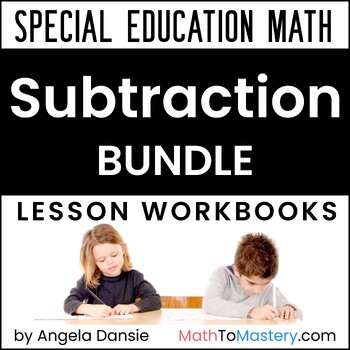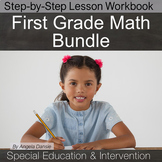Single-Digit Subtraction Lessons & Word Problems, 1st Grade Math Intervention
- Zip
What educators are saying
Products in this Bundle (6)
showing 1-5 of 6 products
Also included in
- This special education first grade math curriculum makes it easy to teach tier 3 math intervention students in a small group setting. Lessons are tied to math standards at the 1st grade level and can be used with students of any age.Math Curriculum for Special Education and Intervention, 1st Grade LPrice $99.00Original Price $159.95Save $60.95
- This special education math curriculum makes it easy to teach tier 3 math intervention students in a small group setting. Lessons are tied to math standards at the kindergarten through 5th grade level and can be used with students of any age.Math Curriculum for Special Education and Intervention KiPrice $299.00Original Price $479.93Save $180.93
Description
This Single-Digit Subtraction Bundle with Word Problems was created for 1st grade math intervention groups and special education students.
These sequential materials will take students seamlessly from learning to subtract single-digits all the way to subtracting from teen numbers and solving for unknowns in all positions.
This Subtraction Bundle includes:
★ Subtracting Teens Minus One-Digit Numbers
★ Fact Families (Addition and Subtraction)
★ Unknowns in All Positions (Addition and Subtraction)
★ Word Problems (Addition and Subtraction)
✎ Each lesson is presented in model, guided practice, independent practice format.
✎ Step-by-step task analysis is included next to each model.
✎ Easy to use. Print and teach.
Please Notice: This bundle does NOT include detailed lesson plans or a teacher manual—only the short and simple lessons as shown in the previews. Please look at the previews carefully before you buy.
Do You Teach Older Students?
These resources include a version with no decorative clip art at the top of pages or on the student booklet cover. Everything else is exactly the same, but you won’t need to worry about whether the clip art might be too young for your students.
************************************************************************
Bundle and Save! This product can also be found in these bundles:
• First Grade Math Lesson Bundle (Intervention & Special Ed)
• Complete Bundle of ALL Step-by-Step Math Workbooks
************************************************************************
Math Resources Bundled by Grade Level:
Math Resources Bundled by Topic:
• Place Value and Number Sense Bundle
• Multi-Digit Addition and Subtraction Bundle
Not sure where to start?
Download a free placement test.
You may also find this blog post helpful:
How to Use Step-by-Step Math to Mastery Resources
Reasons You'll Love Step-by-Step Math to Mastery™ Resources
- Boosts student confidence and progress
- Lightens teacher workload
- Time-saving: print and teach
- Easy prep: only black ink is needed
- Easy to teach, paraeducator-friendly
- Example IEP goals and shorter term objectives
- Consistent & predictable format
- Lots of practice repetitions
- Scaffolded with structured workspaces
- Fewer problems on a page, white space, minimal visual clutter
- Tied to standards
- Explicit/Direct instruction
- Systematic & sequential
- Mastery approach--teaching one topic at a time, one strategy at a time
- Lessons have "I Can" statements, model problems, guided practice, & independent practice
- Each workbook can be used individually as a stand-alone intervention for that skill or they can be used together, taking students from the basics of number sense and addition in first grade all the way to dividing fractions and decimals in fifth grade.
- Can also be used with older students (middle & high school) to help fill the gaps in their learning.
About the Author
Hi! I am a Special Education & Title 1 teacher interested in task analysis. My resources break tasks into small and explicit steps, reducing cognitive load for learners so they can feel successful and confident rather than overwhelmed and reluctant to try. I also strive to lighten the workload of teachers by making resources as practical and easy-to-use as possible. I sincerely hope my work can benefit you and your students.
➜Click to Follow My Store New resources are discounted the first 24 hours!
✏️Click here for Digital Tasks for Special Education
✏️Click here for Word Family Spelling & Word Study resources
✏️Click here for Writing Templates for Special Education
✏️Click here for Step-by-Step Math to Mastery resources
- Go to your My Purchases page
- Click on the Leave a Review button to leave a rating and short comment
- You’ll earn TPT credits, which you can redeem on future purchases
⭐⭐⭐⭐⭐ I Strive for 5 Stars ⭐⭐⭐⭐⭐
Need help? Before leaving feedback:
- Visit the FAQs section
- Submit a help ticket
- Ask a question with the Q&A tab
************************************************************************
I appreciate your support and feedback.
Terms of Use
Copyright © Angela Dansie, All rights reserved. This product is to be used by the original purchaser for single class use only. You may not put this product on the internet where it could be publicly found and downloaded. Copying for more than one teacher, classroom, department, school, or school system is prohibited. If you want to share this resource with colleagues, please purchase additional licenses. Failure to comply is a copyright infringement and a violation of the Digital Millennium Copyright Act (DMCA). Clipart and elements found in this PDF are copyrighted and cannot be extracted and used outside of this file without permission or license. Intended for classroom and personal use only.
Thank you for respecting these terms of use.




